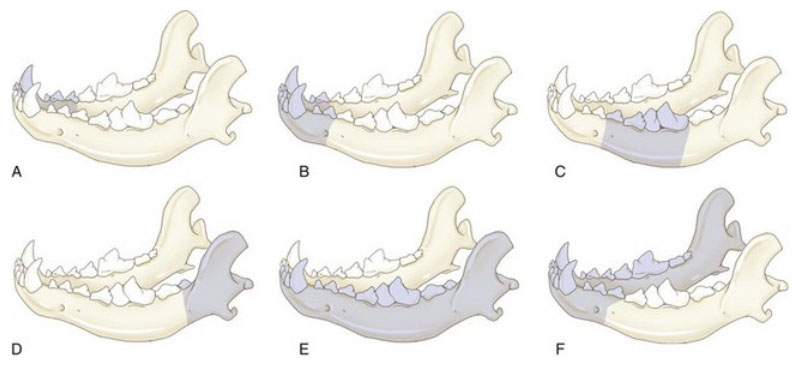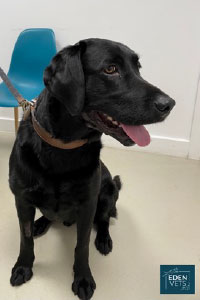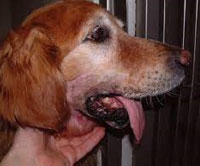What are Mandibulectomy and Maxillectomy Procedures?
Mandibulectomy and maxillectomy procedures are most indicated for the treatment of malignant oral tumours and rarely for benign tumours in dogs and cats. A mandibulectomy is a complete or partial resection of the mandible (the lower jaw). And a maxillectomy therefore is complete or partial resection of the maxilla (the upper jaw).
Dogs
The most common oral tumours in dogs are malignant melanoma, squamous cell carcinoma, fibrosarcoma, osteosarcoma and the benign Acanthomatous ameloblastoma.
The approach to oral tumours requires first a diagnosis to establish what type of tumour we are dealing with and the extent of the lesion (invasion in surrounding tissues close and far). This can be achieved by signalment, fine needle aspirate (where we use a needle and syringe to sample a lump) and as a gold rule biopsy (taking a bit of tissue for analysis) which is done most of the time under a general anaesthetic.
Once we have a histological diagnosis staging is performed. CT scans are at the forefront of enabling us to assess the extent of the tumour invasion and metastasis and allows us to appropriately plan for the surgery. Also, fine needle aspirates of the regional lymph-nodes can be performed at this time.
Surgery depends on the type of tumour and extent of the lesion. Parts of the mandible (lower jaw) or the whole mandible can be removed. Also, parts of the maxilla or most of the maxilla can be removed. You surgeon will discuss the surgical procedure, complications, and risks with you during your extended consultation.


A lot of owners may put off by this type of surgery given the cosmetic implications, however dogs tolerate extensive surgery very well without any ongoing related problems. In one study, 44 months post-surgery 85% of the owners where happy that they opted for the procedure.
Post operatively our dog will remain hospitalised with us for up to several days on supportive care. In a few cases the placement of a feeding tube is required.
Soft food is advised until the surgical site is healed. The most common complication of these surgeries is break down off the surgical sutures (dehiscence) and infection but the majority of these will heal without further intervention. Tooth trauma that may require subsequent tooth extraction is a possibility.


Postoperative Care
Medications: Give any prescribed medication as directed. Do not give human pain medication to pets without first consulting with a veterinarian.
Diet: Feed a softened diet for at least 2-3 weeks. Your pet should be able to lap the food with his or her tongue. Water should be available free choice. If your pet won’t eat voluntarily, try hand feeding your pet. Rarely, animals will not eat for an extended period following this surgery. If your pet isn’t eating in 3-4 days, he or she may need to have a feeding tube placed. Do not allow your pet to have access to chew toys, hard treats, or dry dog food for at least three weeks following surgery.
Exercise: Limit exercise to short leash walks for 2-3 weeks following surgery. Do not allow your pet to rough-house or play with other pets during the period of restricted activity.
Signs of possible complications
Observe your pet for problems, and contact us if you notice any of the following:
• Prolonged listlessness or anorexia
• Foul odour from mouth
• Break-down or openings of incision line
• Visible masses or swelling in the surgical area
Recommended follow up
Please schedule rechecks in approximately 4 days following surgery, and any external sutures may be removed 10 days after surgery. Most oral sutures will be absorbable and will not need to be removed. Please contact us immediately if any of the above problems are noted.
For pets that have had mandibulectomy or maxillectomy procedures performed for oral tumor excision, monthly revaluation for signs of tumor regrowth is recommended.
Cats
The most common oral tumour in cats requiring surgery is squamous cell carcinoma, which is very difficult to treat, due to the extent of the disease, and this carries a poor prognosis. Other tumours, for example fibrosarcoma and osteosarcoma carry an excellent long-term prognosis with successful surgery. The investigatory and diagnostic procedures are the same as mentioned above for dogs.
The surgery is tolerated well by cats if only small amounts of the maxilla or mandible are removed. When compared to dogs, cats will often refuse to eat post-surgery and as such a feeding tube is a pre-requisite most of the time. Again, the complications, post-operative care and follow up is the same as for dogs.
Survival rates at 1-2 years post-surgery in cats is around 50% but the owner satisfaction with the procedure was around 83%. With appropriate case selection and aggressive management in the early post operative period, cats can have a prolonged survival and an excellent quality of life after mandibulectomies.
Prognosis
The prognosis for excellent function and quality of life for dogs following reconstructive facial surgery is quite good. Dogs generally adapt easier than cats to these procedures. Slight facial deformity is expected but is usually found to be quite acceptable to most owners. A slight increase in drooling is occasionally noted following mandibulectomy. The long-term prognosis relating to the tumor removed is quite variable and will depend on the tumor type. For certain aggressive types of tumors, additional treatments such as radiation and/or chemotherapy may be indicated. The commonly reported survival percentage at one year post surgery is 70-90%.
Your pet’s recovery and well-being are our primary concerns, so please do not hesitate to call and speak with a surgical technician or surgeon if there are any questions regarding your pet’s recovery
